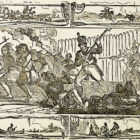Battle of Tallushatchee
Battle of Tallushatchee

The Battle of Tallushatchee was a battle fought during the War of 1812 and Creek War on November 3, 1813, in Alabama between Red Stick Creeks Native Americans and United States dragoons. A cavalry force commanded by Brigadier General John Coffee was able to defeat the Creek warriors.

After the massacre at Fort Mims, General Andrew Jackson assembled an army of 2,500 Tennessee militia. Jackson began marching into Mississippi Territory to combat the Red Stick Creeks. Jackson’s troops began to construct Fort Strother along the Coosa River. 15 miles (24 km) away from the fort lay the Creek village of Tallasseehatchee where a sizeable force of Red Stick warriors were. Jackson ordered his friend and most trusted subordinate, General John Coffee, to attack the village.
This was the first of the battles of Gen. Andrew Jackson’s army in his campaign against the Indians in the Creek Indian War of 1813-14. It was fought November 3, 1813, between the hostile Creek Indians collected in the town of Tallaseehatchee, and the forces of Gen. Jackson, under the immediate command of Gen. John Coffee. Gen. Jackson was moving his army with difficulty, owing to much needed supplies. Gen. Coffee had destroyed Black Warrior’s Town; and Col. Dyer had burned the town of Littafuchee. The army now had reached Ten Islands on the Coosa River, and Gen. Jackson began planning the erection of Fort Strother. Gen. Coffee was directed to advance on Tallaseehatchee with 920 men. He was accompanied by Richard Brown and a company of Creeks and Cherokees. The town was situated near the head of the creek of that name, about three miles southwest of Jacksonville. It had about 100 families, and a fighting force of 120 warriors, had only recently been increased by 300 warriors, brought together from the towns below, making an Indian force of 420 fighting men. Gen. Coffee surrounded the town about sunrise of November 3. The engagement was swift and bloody. Not an Indian asked to be spared. There is some discrepancy in the accounts of those engaged, but the Indian killed were 186 warriors who were counted, and 18 Indian women. A number were never counted. Some escaped, and fled toward Oakfushee. Gen. Coffee’s losses were five killed and 41 wounded. Eighty-four women and children, and fourteen hopelessly crippled warriors were taken prisoners. The prisoners were sent to Huntsville.
On the same day, Gen. Coffee returned to headquarters.
Of their arms and equipment in this battle, Brewer says-“A noticeable circumstance in connection with this battle is that the Indians were all armed with a bow and quiver of arrows, besides guns, which showed that they had taken to heart the advice of Tecumseh to throw aside the arts they had learned from the whites, and return to their primitive customs.
Buell says, p. 304: “An interesting feature of this encounter was the fact that it was Coffee’s first battle. In his conduct of it, however, he exhibited skill and precision worthy a veteran of many fields. Coffee was an instinctive soldier, an intuitive general. Long after when his native capacity had been developed in many hard-fought encounters, including the battle of the 23d below New Orleans, Gen. Jackson said of him: ‘John Coffee is a consummate commander. He was born so. But he is so modest that he doesn’t know it.’ “
On the death of Gen. Coffee in 1834, Gov. William Carroll of Tennessee said of him in a funeral eulogy: “In view of all the circumstances, I had rather have been the hero of Tallaseehatchee than of the Horseshoe Bend. I had almost said New Orleans itself! It was the first battle of the Creek campaign; the first battle fought by any troops under Andrew Jackson’s command. Upon its issue depended in great measure the morale of our troops, their confidence in their leaders and the buoyancy of spirit that would nerve them to endure the indescribable fatigues and privations to which they were subjected.”
Buell, p. 305.Source: Compiled in 1921 by Thomas McAdory Owen, LL.D
REFERENCES. —- Pickett, History of Alabama (Owen’s ed., 1900), p. 552; Brewer, Alabama (1872), p. 152; Parton, Life of Jackson (1861), vol. 1, pp. 436-440; Buell, History of Andrew Jackson (1904), vol. 1, pp. 302-305; Eaton, Life of Jackson (1824), pp. 53-55; (Eaton), Memoirs of Andrew Jackson (1848), pp. 48-49; Jenkins, Life of Jackson (1852), pp. 65-67; Frost, Pictorial Life of Jackson (1847), pp. 132-137; Colyar, Life and Times of Jackson (1904), vol. 1, pp. 127-128.Additional information on the Battle of Tallushatchee is available at Encyclopedia of Alabama.
